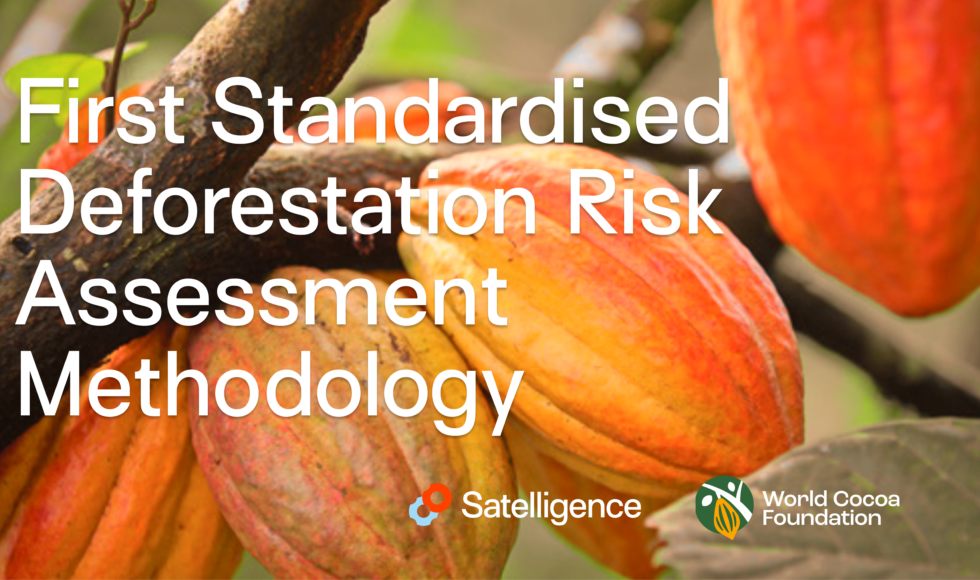From December 2025, the European Union Deforestation Regulation (EUDR) will require importers of key commodities (including cocoa) to prove their products were produced on land free of deforestation.
Unfortunately, there are a lot of concerns about how EUDR rules will be enforced. While many isolated methods, risk management systems, and basic deforestation maps have recently emerged, they lack widespread recognition and integration.
In an unprecedented effort of industry-wide cooperation, World Cocoa Foundation, Satelligence, and the cocoa industry worked together with authoritative EU institutions to collectively define a consensus-based sector-wide approach for EUDR Risk Assessment.
Satelligence’s monitoring of forests, deforestation and, in particular, the unique global mapping of where cocoa grows plays a key role in this approach.
Part of the concerns about EUDR stems from the fact that it is hard to determine where cocoa is responsible for deforestation. The public maps widely thought to be used as proof do not properly distinguish green plantations from green natural forests. Plantation crops such as cocoa and coffee have never before been mapped in great detail across the entire planet. For the past ten years, Satelligence worked with leading cocoa clients to perfect such cocoa and forest mapping. By standardising how cocoa and cocoa-driven deforestation is detected, Satelligence’s data sources help eliminate discrepancies across supply chains.
Only with good global satellite coverage in combination with an extensive local network can you determine where cocoa actually grows and avoid fines, trade interruptions and other hassles, Niels Wielaard, CEO of Satelligence.
Better mapping of cocoa minimises the risk of farmers being unintentionally excluded from supply chains when potential deforestation is flagged due to inaccurate forest maps, but none has actually taken place.
Making the methodology and data accessible and affordable to smallholder farmers in cooperation with Fairtrade International, Solidaridad, and others has been a key focus for Satelligence. The efforts to unlock smallholder-inclusive technology resulted in the service being recognised as the Best Product 2024 by the EU Agency for the Space Programme (EUSPA).
The endorsement by authoritative European institutions underscores its significance. Developed with input and feedback from the European Cocoa Association and the European Forest Institute, the methodology provides step-by-step guidance that simplifies compliance with EUDR controls.
We can now provide more reassurance that our approach is grounded in a known and accepted approach. This is a big relief for our large and rapidly growing client base, Niels Wielaard.
By establishing best practices for data and processes, the new methodology will boost confidence in cocoa traceability and cocoa sustainability. It will enable companies to gain greater assurance regarding the cocoa passing through their supply chains.
Satelligence has always spearheaded collective action and partnerships to make sourcing more sustainable. In 2019, the company brought together a coalition of ten major palm oil producers and buyers to support and fund the development of a new radar-based forest monitoring system for more frequent observation in the cloudy tropics. The data is now available for the public good.
By helping the cocoa sector adopt a unified best-practice deforestation detection methodology tailored to the feedback of EU stakeholders, we created a reliable standard that directly supports EUDR compliance and beyond, Alan Kroeger, Nature & Climate Director at Satelligence.
“Collective action builds trust and transparency among all stakeholders—including governments—ensuring that the path forward is both simpler and more effective as we all work towards a deforestation-free cocoa sector,” Alan continues.
We have also incorporated producer country land cover data, where available. Working from a streamlined process and unified evidence base will save our clients engagement time and costs and significantly help to avoid hefty fines and potential trade disruptions related to non-compliance.
This methodology provides the cocoa sector with a standardised, accurate way to assess the risk of deforestation in their supply chains for EUDR compliance, Michael Matarasso, Director of Monitoring and Evaluation at WCF.
“We are grateful to our members and technical partners, such as Satelligence, for their expertise in this field and the strong collaborative approach necessary to develop something as important as this. We look forward to seeing our members put the methodology into practice,” continues Michael.
The scientifically verified method and data are currently being rolled out across the entire cocoa industry. In the meantime, lessons learnt are paving sustainable paths for other industries, including palm oil, soy, and coffee. Trial shipments assessed in consultation with relevant authorities are already expected to arrive in Europe’s ports over the coming weeks.
About Us
Satelligence is the satellite-powered geo-data analytics company providing daily insights into the global performance of agricultural production and supply chain risks, such as deforestation and vegetation fires. We help clients including Mondelez, Unilever, Bunge, Cargill and Rabobank to confidently measure, manage and mitigate risk, make the right sourcing and investment decisions, and demonstrate progress. By providing unparalleled supply chain insights, Satelligence’s risk monitoring drives a profitable, equitable and climate-positive future that protects businesses, people and the planet. Our team operates from offices in Utrecht, Jakarta, Abidjan, and São Paulo.
